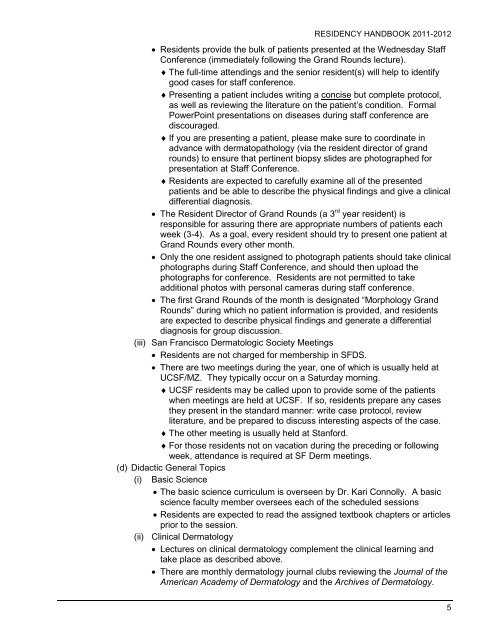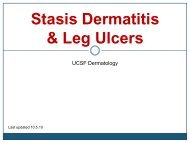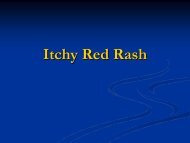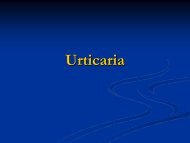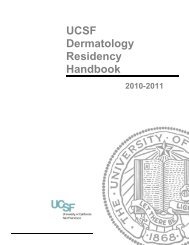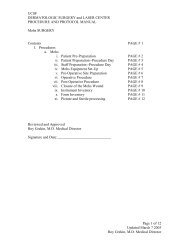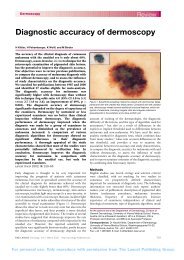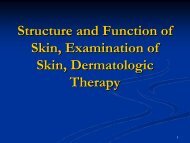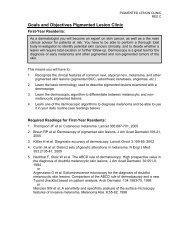UCSF Dermatology Residency Handbook - Dermatology - University ...
UCSF Dermatology Residency Handbook - Dermatology - University ...
UCSF Dermatology Residency Handbook - Dermatology - University ...
You also want an ePaper? Increase the reach of your titles
YUMPU automatically turns print PDFs into web optimized ePapers that Google loves.
RESIDENCY HANDBOOK 2011-2012<br />
• Residents provide the bulk of patients presented at the Wednesday Staff<br />
Conference (immediately following the Grand Rounds lecture).<br />
♦ The full-time attendings and the senior resident(s) will help to identify<br />
good cases for staff conference.<br />
♦ Presenting a patient includes writing a concise but complete protocol,<br />
as well as reviewing the literature on the patient’s condition. Formal<br />
PowerPoint presentations on diseases during staff conference are<br />
discouraged.<br />
♦ If you are presenting a patient, please make sure to coordinate in<br />
advance with dermatopathology (via the resident director of grand<br />
rounds) to ensure that pertinent biopsy slides are photographed for<br />
presentation at Staff Conference.<br />
♦ Residents are expected to carefully examine all of the presented<br />
patients and be able to describe the physical findings and give a clinical<br />
differential diagnosis.<br />
• The Resident Director of Grand Rounds (a 3 rd year resident) is<br />
responsible for assuring there are appropriate numbers of patients each<br />
week (3-4). As a goal, every resident should try to present one patient at<br />
Grand Rounds every other month.<br />
• Only the one resident assigned to photograph patients should take clinical<br />
photographs during Staff Conference, and should then upload the<br />
photographs for conference. Residents are not permitted to take<br />
additional photos with personal cameras during staff conference.<br />
• The first Grand Rounds of the month is designated “Morphology Grand<br />
Rounds” during which no patient information is provided, and residents<br />
are expected to describe physical findings and generate a differential<br />
diagnosis for group discussion.<br />
(iii) San Francisco Dermatologic Society Meetings<br />
• Residents are not charged for membership in SFDS.<br />
• There are two meetings during the year, one of which is usually held at<br />
<strong>UCSF</strong>/MZ. They typically occur on a Saturday morning.<br />
♦ <strong>UCSF</strong> residents may be called upon to provide some of the patients<br />
when meetings are held at <strong>UCSF</strong>. If so, residents prepare any cases<br />
they present in the standard manner: write case protocol, review<br />
literature, and be prepared to discuss interesting aspects of the case.<br />
♦ The other meeting is usually held at Stanford.<br />
♦ For those residents not on vacation during the preceding or following<br />
week, attendance is required at SF Derm meetings.<br />
(d) Didactic General Topics<br />
(i) Basic Science<br />
• The basic science curriculum is overseen by Dr. Kari Connolly. A basic<br />
science faculty member oversees each of the scheduled sessions<br />
• Residents are expected to read the assigned textbook chapters or articles<br />
prior to the session.<br />
(ii) Clinical <strong>Dermatology</strong><br />
• Lectures on clinical dermatology complement the clinical learning and<br />
take place as described above.<br />
• There are monthly dermatology journal clubs reviewing the Journal of the<br />
American Academy of <strong>Dermatology</strong> and the Archives of <strong>Dermatology</strong>.<br />
5


